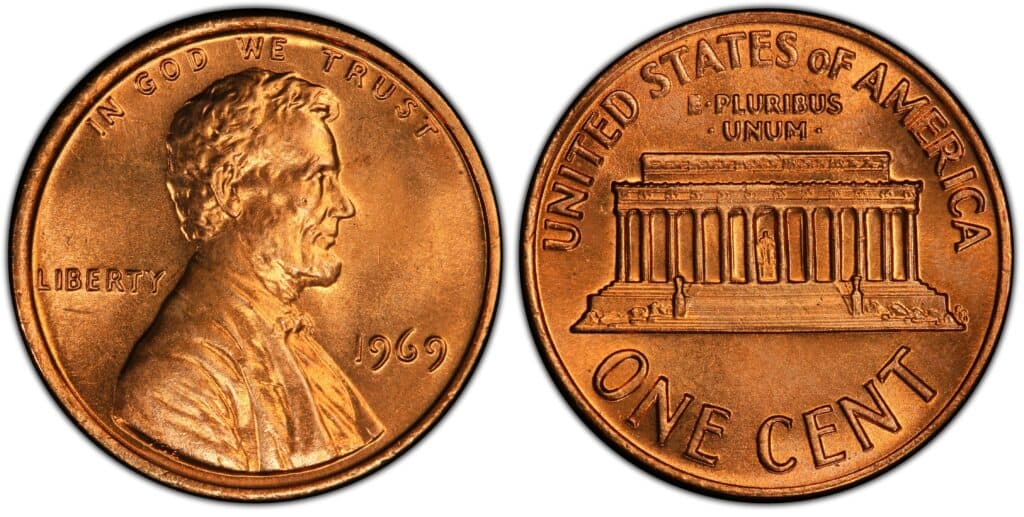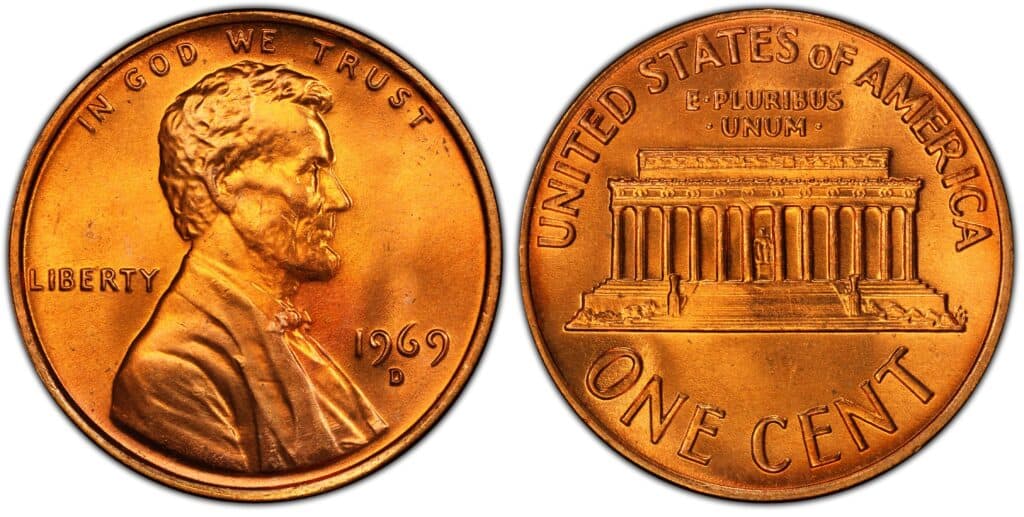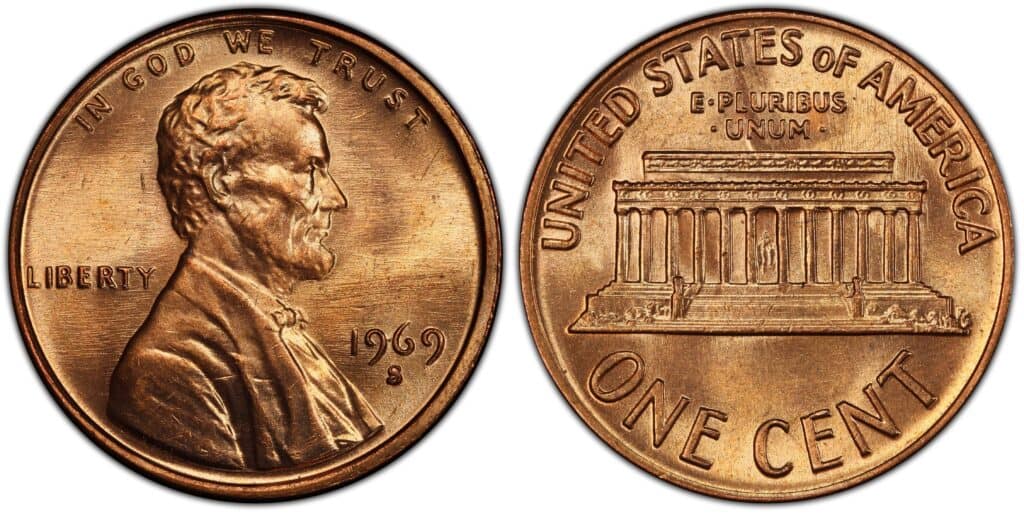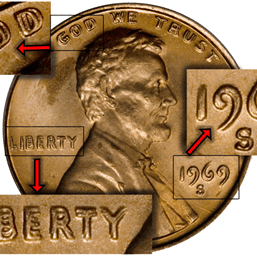What Is Special About A 1969 Lincoln Penny?
The 1969 Penny features the bust of Abraham Lincoln (obverse side) as well as the image of the Lincoln Memorial (reverse side). For this reason, the 1969 penny is also called the Lincoln memorial cent. One can still remember that before 1969, the penny features an image of wheat instead of the Lincoln Memorial on its tail side.
In terms of design, you’ll find the word “Liberty” engraved on the left side of Abraham Lincoln.
On the right side is the “1969” figure.
Below 1969, you may find a small letter “S” or “D”, which refers to the minting facility where it was created. S stands for San Francisco and D is for Denver.
Sometimes, there’s no letter at all, which could mean it was minted in Philadelphia.
In total, Denver minted the most number of 1969 penny. They have minted more than 4 billion 1969 coins. Philadelphia comes next with about 1.14 billion coins and San Francisco minted 544 million plus penny coins.
On top of the head of Abraham, you’ll see an inscription, “In God We Trust.”
On the opposite side of the coin, you’ll find the Lincoln Memorial at the center. On top is “United States of America” and below is “One Cent.” Between the memorial image and United States of America, a text is inscribed, “E. Pluribus Unum,” which is the motto of the country. It means “out of many, one.”
The composition of the 1969 penny is 95% copper and the rest is a mixture of zinc and tin.
1969 Lincoln Penny Varieties
The 1969 penny comes with various designs. Here’s a quick overview of its varieties.
1969 Lincoln Penny With No Mint Mark
Metal composition: 95% copper
Weight: 2.5 g

The 1969 penny with no mark is most likely minted in Philadelphia. It looks just like other 1969 pennies. However, the main difference is it doesn’t have a mint mark that other varieties have.
1969 D Lincoln Penny
Metal composition: 95% copper
Weight: 3.11 g

The 1969 D penny has the letter “D” found below the year “1969.” Today, this coin can easily be found since there are still a lot of it in circulation. However, coins may differ in their grade. The high-grade coins are more valuable.
1969 S Lincoln Penny
Metal composition: 95% copper
Weight: 3.11 g

The 1969 S penny is the penny variety with the letter “S” found below the year “1969.” It indicates that it has been minted in San Francisco. Because most of these pennies are kept in safes and are well preserved, you should be able to find some of them with little difficulty.
1969 Penny errors
Metal composition: 95% copper
Weight: 3.11 g

Aside from the normal penny variety, there are pennies that have been minted with errors. Some have misformed letters, double-struck outlines, floating Lincoln memorial roofs, and others.
Are There Any Rare 1969 Pennies?
Yes, there are extremely rare 1969 pennies. Usually, these pennies are unique in various ways due to some minting errors.
One good example of these rare 1969 pennies is the 1969 S penny that comes with a doubled die error. It means that the date and design outlines were struck twice.
Thus, you can see that there are duplicate elements. One 1969 S penny with doubled die error was once sold for $45,000.
Now, you might ask, “Is a 1969 D penny rare?”
No, it’s not rare. It is fairly easy to find a 1969 D penny today. Because of this, the 1969 D penny isn’t worth much to some collectors.
Another question you might have is, “How much is the value of a 1969 s-floating roof penny?”
The answer is it depends.
There are floating roof pennies that only sell between $1 and $3. However, one eBay seller offers his 1969 S Lincoln Penny Floating Roof for $1,200.
How Much Is A 1969 Penny Worth Today?
Today, an ordinary 1969 penny isn’t worth that much. These 1969 pennies can even be found in pocket change. Yes, they are easy to find today. However, as time passes by, these pennies will eventually decrease in number and thereby, increase their value.
So, given enough time, your 1969 penny may be worth hundreds or even thousands of dollars in the future.
Of course, even if they are common right now, there are 1969 pennies that are worth a lot of money. Usually, the rarer and more preserved the penny is, the higher its price.
Today, 1969 doubled die pennies are the rarest variety of pennies, which dramatically increase their value.
Regarding the melt value of the 1969 penny, it is usually determined by its weight in the metal it is made of, which in this case, copper. The melt value of copper is $0.02, which is also the melt value of the 1969 penny.
To give you an idea of the usual value of 1969, take a look at the table below. Here are the top 10 most valuable Lincoln pennies listed for MS-65 certification.
| Rank | Year | Mint | Worth |
| 1 | 1961 | D | $75 |
| 2 | 1982 | $45 | |
| 3 | 1959 | D | $40 |
| 4 | 2006 | D | $35 |
| 5 | 1961 | $32 | |
| 6 | 1975 | D | $30 |
| 7 | 2002 | D | $30 |
| 8 | 1962 | $29 | |
| 9 | 1962 | D | $29 |
| 10 | 2002 | $27 |
How Does The Grading System Work?
The Sheldon Scale is used by numismatists to provide a numerical value to coins. The Sheldon Scale goes from poor (P-1) to perfect mint state (P-1) (MS-70). Coins were originally evaluated using words to reflect their condition (Good, Fair, Excellent, Etc.). Unfortunately, coin collectors and dealers had different ideas about what each of these terms represent.
Professional numismatists joined together in the 1970s and established CoinGrading standards. These numismatists now assign grades at key places on the seventy-point scale, using the most regularly utilized numeric points in conjunction with the original adjective grade. The following are the most common coin grades:
-
-
- (P-1) Poor – Indistinguishable and probably damaged; if used, must have a date and mintmark; otherwise, rather battered.
- (FR-2) Fair – Nearly smooth, but without the damage that a coin graded Poor often possesses. The coin must have enough detail to be identified.
- (G-4) Fair – Inscriptions have merged into the rims in some areas, and important elements have been mostly erased.
- (VG-8) Very Good- A little weathered, but all of the primary design elements are visible, albeit faintly. There is little if any, central detail left.
- (F-12) Good – The item is very worn, yet the wear is even, and the overall design details stand out clearly. Rims are almost completely isolated from the field.
- (VF-20) Very Fine – Moderately weathered, with some finer features still visible. The motto or all letters of LIBERTY are readable. Both sides of the coin have entire rims that are separated from the field.
- (EF-40) Extremely Fine – Gently used; all gadgets are visible, and the most important ones are bold. The finer details are bold and clear, however, light wear may be seen.
- (AU-50) Uncirculated – Slight evidence of wear on the coin’s design’s high points; may have contact marks; eye appeal should be adequate.
- (AU-58) Uncirculated Choice – Slight traces of wear, no severe contact marks, almost full mint shine, and great eye appeal.
- (MS-60) Mint State Basal – Strictly uncirculated; no indication of wear on the coin’s highest points, but an unsightly coin with reduced luster, visible contact marks, hairlines, and other flaws.
- (MS-63) Mint State Acceptable – Uncirculated, but with contact scratches and nicks, little reduced shine, but otherwise appealing appearance. The strike is weak to average.
- (MS-65) Mint State Choice – Uncirculated with great mint shine, very little contact blemishes, and exceptional eye appeal. The strike is unusually severe.
- (MS-68) Mint State Premium Quality – Uncirculated with superb luster, no obvious contact marks to the naked eye, and exceptional eye appeal. The strike is quick and appealing.
- (MS-69) Almost Perfect Mint State – Uncirculated with perfect brilliance, a sharp and appealing strike, and extremely good eye appeal. A near-perfect coin with minor imperfections in the planchet, strike, and contact markings (seen only under 8x magnification).
- (MS-70) Mint State Perfect – Under 8x magnification, there are no tiny imperfections discernible; the strike is crisp, and the coin is perfectly centered on a beautiful planchet. Rarely seen on a coin, this coin is bright and whole, with original luster and exceptional eye appeal.
-
Where To Buy Or Sell 1969 Pennies?
In this time and age, buying or selling 1969 pennies has been made easier. Because of the Internet, people can easily put up their pennies online. Both buyers and sellers can simply meet on the web before they meet in person or a transaction is made.
Some of the most common places where you can buy 1969 pennies include eBay, social media networking sites such as Facebook, Etsy, and other online buy and sell platforms.
Other places you can buy 1969 pennies would be brick-and-mortar stores. You can go to antique shops, collectors’ places, and other private sellers.
If you’re planning to sell your coin, you can join coin collectors’ social clubs where you’ll find coin enthusiasts.
FAQs
What is the value of a 1969 Canadian penny?
The 1969 Canadian penny generally sells at around $0.02 to $0.04 CAD.
What is a floating roof on a 1969 D penny?
On the 1969 D penny’s reverse side, you’ll find an image of Lincoln Memorial. Due to a striking error, the roof of the Lincoln Memorial isn’t completely attached to the rest of the building. This makes the roof look like it is floating.
Are all 1969 S pennies doubled die?
No. Doubled-die pennies are a rare occurrence and are not done intentionally. Although minting is performed in the best way possible, there are still 1969 pennies that were doubled die. Today, these doubled-die pennies are more valuable than their normal counterparts.
